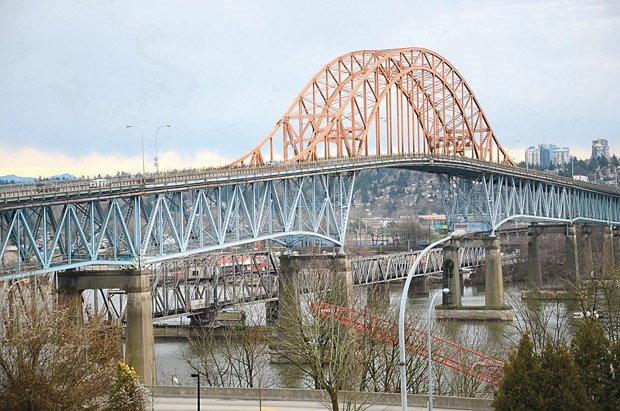The City of New Westminster’s Pattullo Bridge tour is getting mixed reactions from municipal councils – and prompting some of its closest neighbours to take a position contrary to the city’s pitch.
Members of New Westminster city council and staff have been visiting councils throughout Metro Vancouver to explain the city’s support for a four-lane, tolled replacement for the Patttullo Bridge. The latest stops on the tour were White Rock and North Vancouver.
Along the way, city representatives have received a range of feedback from their fellow Lower Mainland politicians, with some having sympathy for the city’s traffic woes in light of increased traffic crossing the Pattullo Bridge to avoid tolls on the Port Mann Bridge. Others, including Port Moody and Port Coquitlam, have called the tour “odd” as they believe the matter should be dealt with at the regional level.
Coquitlam city council recently expressed a preference for a six-lane replacement of the Pattullo Bridge. Coquitlam Mayor Richard Stewart told The Record transportation decisions need to be considered regionally, rather than locally.
“All too often I think we run into local decision making about regional transportation issues, and if all 22 of us did that we would end up with a region that completely failed economically from every measure,” Stewart said. “Having listened to colleagues across the region, I think our community feels it would be more productive to have a six-lane capacity for the long-term.”
As a “compromise” to New Westminster’s support of a four-lane crossing, Stewart said Coquitlam city council supports dedicating two lanes for transit and HOV initially, until the additional capacity is needed.
Working with local municipalities, TransLink began with 25 options for replacing the Pattullo Bridge and narrowed them down to six options it believes merit further evaluation. These include: rehabilitating the existing Pattullo Bridge to three or four lanes; building a new four-, five- or six-lane bridge at the existing crossing; or building a new four-lane Surrey to Coquitlam Bridge (with a two- or three-lane rehabilitation to the existing Pattullo Bridge).
While New Westminster has stated there’s no room on this side of the river to accommodate six lanes without infringing on Queen’s Park or residential areas, Stewart said TransLink wouldn’t be proposing the option if it wasn’t considered technically possible.
“Now we have to figure out which is in the region’s best interest and New Westminster’s best interest, and hopefully they are the same. If they’re not, then we’ve got work to do to try and make one of them work and try to overcome some of the challenges.”
According to Stewart, New Westminster isn’t the only community facing increased traffic. He said Coquitlam now has 20 east/west lanes of traffic that are meant for people from Port Coquitlam, Maple Ridge and Surrey to get to Vancouver, Burnaby, Surrey, Richmond and New Westminster.
“I can only think of one community that doesn’t have traffic going through it. That is Belcarra – it’s at the end of the road,” he said. “The rest of us accommodate traffic from our neighbours. If this were one metropolitan region, none of these decisions would be being made like this. They would be made on the basis of what’s best for the region.”
Surrey hasn’t taken a formal position on the Pattullo Bridge, but some of its councillors have also been pushing for a six-lane crossing. Upon learning of Coquitlam’s preference for a six-lane crossing, New Westminster Mayor Wayne Wright told The Record a six-lane bridge from Surrey to Coquitlam would work, and that way they’d both get the number of lanes councillors prefer.
That’s something Coquitlam’s mayor is willing to look at as an alternative to the Surrey to New Westminster bridge.
“We always want to work with our neighbours, and that one would have the effect of dumping traffic into Coquitlam, but at a place that would perhaps be able to mitigate the impact of that traffic,” he said. “I like the option. I recognize that the engineers have said it is potentially cost prohibitive. I like the option – the goal here isn’t to dump traffic in the wrong place; the goal is to make certain, as much as we can, that we deal with the regional transportation needs.”



